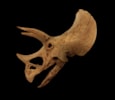The Harrods Triceratops Skull
The Harrods Triceratops Skull
Triceratops prorsus
Maastrichtian, Late Cretaceous Period
68-66 million years ago
Discovered: Hell Creek Formation, Montana
Fossilised organic bone material
Length of skull: 190cm Width: 118cm
Sold
An extraordinarily complete skull of a Triceratops prorsus, one of the two species of Triceratops known to have roamed the plains of what is now North America around 68-66 million years ago. It was the most numerous of the horned cretaceous dinosaurs as well as the largest ceratopsian, and one of the last to become extinct in the mass extinction event approximately 66 million years ago.
One of the most famous species of dinosaur, its flaring bony frill, pointed beak and three-horned head make the Triceratops instantly recognisable. Today two species of Triceratops are accepted; the earlier T. horridus, which is characterised by a smaller nose horn and long beak, and the later evolution of T. prorsus, with its longer nose horn and shorter beak, of which this skull is a fine example.
The first specimen of Triceratops found was a pair of horns discovered in 1887 in Colorado and initially mistaken for a Pliocene bison. American palaeontologist Othniel Charles Marsh realised the mistake and catalogued the two species of horridus and prorsus in 1889 and 1890 respectively. The first mounted skeleton was displayed by the Smithsonian in 1905 (and is still on display).
A herbivore, the Triceratops grazed on the plentiful low-lying plants of its lush habitat. Its menacing horns were largely for protection, as Triceratops lived contemporaneously with the Tyrannosaurus Rex and, as the largest herbivore, most likely made up the majority of its prey. Many skulls found have been damaged in what appear to be predator attacks, and examples have even been found with Tyrannosaur tooth marks and new growth after breakage.
Its head was up to one-third the length of its body, and is the largest known skull of any land animal. The flaring frill, one of the most recognisably idiosyncratic features of the Triceratops, was ostensibly for protection, although studies have shown it may have originally been brightly coloured and therefore functions as diverse as mating rituals, helping to identify one another, and even to regulate body temperature have been postulated.
Discovered in 2022, on private land known as the McDonald Ranch, Garfield County, Montana, USA at the coordinates 47°35'16.1"N, 106°29'16.5"W
Prepared and mounted in Germany
Accompanied by German export licence.
With IADAA certificate.










 Enquire
Enquire




